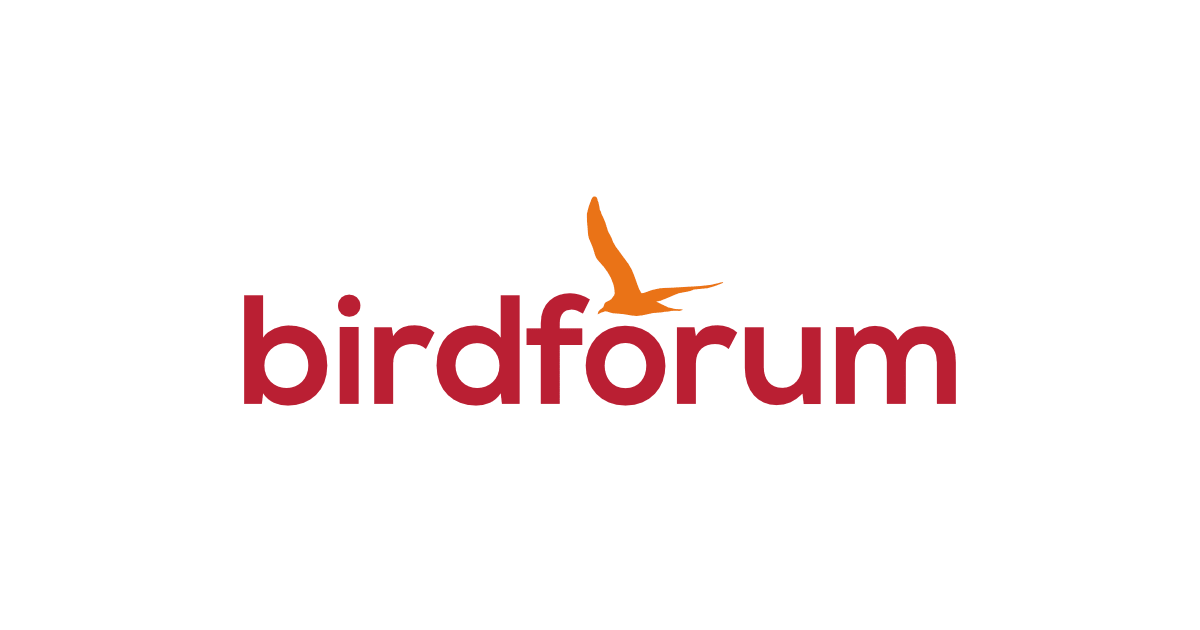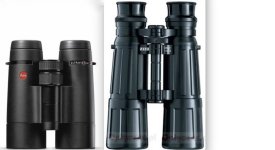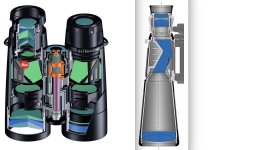So these two are what I've been using lately. Another case of I really like 'em both. Two completely different platforms and both executed very nicely. I was very surprised I'd like and enjoy the Trinovid 7X35 as much as I have. A 7X with 35mm objectives is really about perfect. Small in stature and plenty of light. Smoothest focus adjustment you'll ever find along with great ergonomics(for me) and great optics AND is the prettiest binocular you're ever likely to hold.
Cue the UVHD+ 8X32, a binocular I never thought I'd own. I tried one one year at the optics tent at Magee Marsh and the ER let me down. VERY close to enough but just not quite there. Lately I got new eyeglasses. The prescription is a little different and the frames are a little different and maybe my eyes have changed some as I've noticed I needed a little less ER lately. I saw a great deal on a new 8X32 so I bought it. As it turns out the ER is perfect with the eyecups all the way down/in.
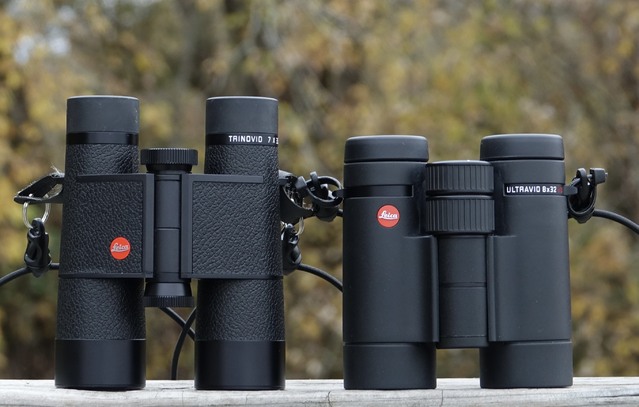
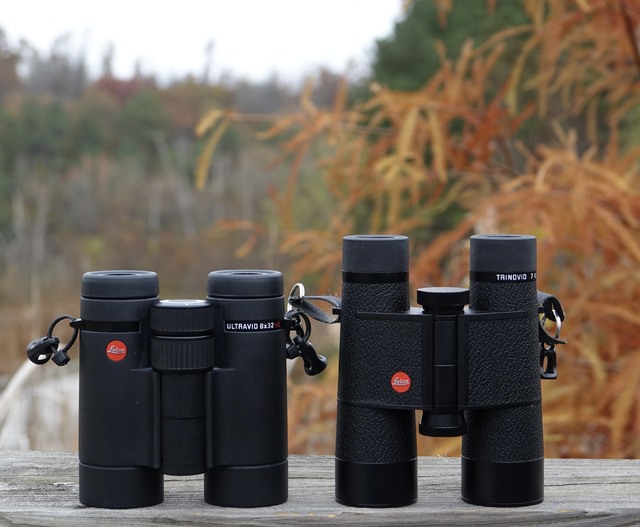
Some comparisons:
Weight. I'm going to include a few other binocular weights as well
UVHD+ 8X32- 18.7oz
Retrovid 7X35- 20.3oz
Monarch HG 8X30- 16.2oz
CL 8X30 B- 16.8oz
SV 8X32- 20.6oz
NL 8X32- 23.2 oz
I really can't tell the 1.6oz difference between the UVHD+ and the Retrovid during use. The Retrovids weight is a little more spread out. At 16.2oz it's easy to see why I like/use the MHG so much.
Eye relief
The UVHD+ 8X32 IS the low man on the totem pole here. In fact it's so low I'm hesitant to recommend to fellow eyeglass wearers. I have zero extra room. I don't think there are very many eyeglasses wearers that require less ER than I do either. I use the Retrovid at the first stop up on the eyecups. Plenty and extra ER for me. The next picture shows the eyecup setting and the ER difference between the two for me. You can also easily see the difference in the style and size of the focus wheel.
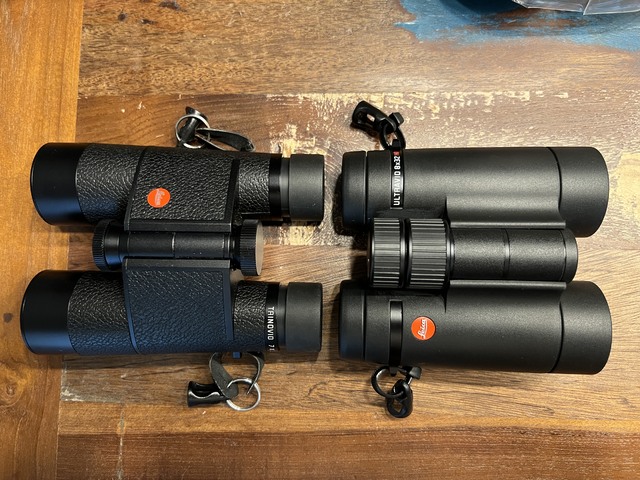
Optics
FOV- Of course the Retrovid is slightly better here- 420ft vs. 408ft. Really this 12ft is not really that significant. You really have to look to see it.
Brightness- I did notice the Retrovid is maybe ever so slightly brighter. House of Outdoors verified this with a transmission of 92% for the Trinovid and 89.2% for the UVHD+. I didn't know the exact numbers until I looked them up tonight....BUT I did know UVs have stayed around 87-89% transmission for years. ALSO the 7X35 does have a slightly larger exit pupil. Regardless of whatever brightness difference there may be it is again of no consequence and barely noticeable.
Resolution- Here, the UVHD+ seemed to have a very slight advantage. No measuring of any type done just in the field use. Again both are excellent with no real benefit here. I'll also say the UVHD+ does seem to have a slightly flatter FOV.
Focus- No doubt the Retrovid has about the smoothest focus adjustment you'll ever find on a binocular. The wheel is a little thin and metal which I thought would be an issue until I actually bought it and used it. It IS a little slow. My sample of the UVHD+ 8X32 has the smoothest focus of any UV I've ever had. It's also huge and much faster than the Trinovid. Don't forget UVs have the easiest/best dioper setting adjustment on the market.
Which do you keep?
I love binoculars, especially really good ones. Both of these are really good ones. BEAUTIFUL binoculars even. I believe I like the 8X32 UVHD+ better as an overall birding better. It's smaller, lighter, larger focus wheel, better armored, very slightly better optics, and is waterproof. BUT...I've got nice 8X30s that are smaller/lighter still with more FOV. There are 8X32s that will sllghtly better the UVHD+ 8X32 in most areas. Still, I like this binocular more than I ever thought I would. Call it intangibles. The Retrovid 7X35 has even MORE intangibles! Why even buy a retro-deign in the first place? It's not waterproof. No real armoring. Thin focus wheel. Still, a quality 7X are as hard to find as frogs teeth. A quality 7X35 even harder.
I'm not getting rid of either!
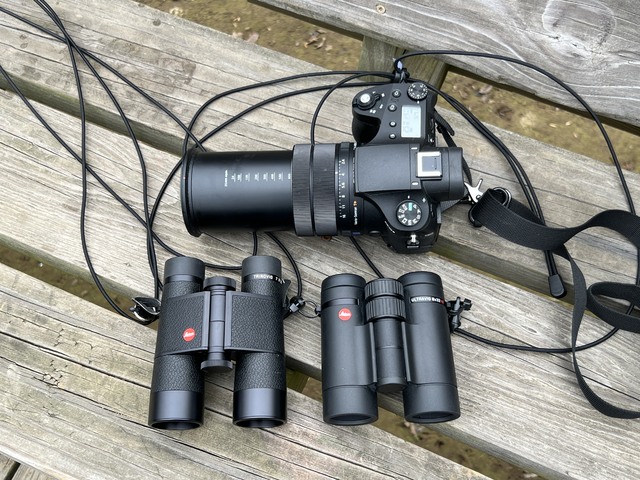
Cue the UVHD+ 8X32, a binocular I never thought I'd own. I tried one one year at the optics tent at Magee Marsh and the ER let me down. VERY close to enough but just not quite there. Lately I got new eyeglasses. The prescription is a little different and the frames are a little different and maybe my eyes have changed some as I've noticed I needed a little less ER lately. I saw a great deal on a new 8X32 so I bought it. As it turns out the ER is perfect with the eyecups all the way down/in.


Some comparisons:
Weight. I'm going to include a few other binocular weights as well
UVHD+ 8X32- 18.7oz
Retrovid 7X35- 20.3oz
Monarch HG 8X30- 16.2oz
CL 8X30 B- 16.8oz
SV 8X32- 20.6oz
NL 8X32- 23.2 oz
I really can't tell the 1.6oz difference between the UVHD+ and the Retrovid during use. The Retrovids weight is a little more spread out. At 16.2oz it's easy to see why I like/use the MHG so much.
Eye relief
The UVHD+ 8X32 IS the low man on the totem pole here. In fact it's so low I'm hesitant to recommend to fellow eyeglass wearers. I have zero extra room. I don't think there are very many eyeglasses wearers that require less ER than I do either. I use the Retrovid at the first stop up on the eyecups. Plenty and extra ER for me. The next picture shows the eyecup setting and the ER difference between the two for me. You can also easily see the difference in the style and size of the focus wheel.

Optics
FOV- Of course the Retrovid is slightly better here- 420ft vs. 408ft. Really this 12ft is not really that significant. You really have to look to see it.
Brightness- I did notice the Retrovid is maybe ever so slightly brighter. House of Outdoors verified this with a transmission of 92% for the Trinovid and 89.2% for the UVHD+. I didn't know the exact numbers until I looked them up tonight....BUT I did know UVs have stayed around 87-89% transmission for years. ALSO the 7X35 does have a slightly larger exit pupil. Regardless of whatever brightness difference there may be it is again of no consequence and barely noticeable.
Resolution- Here, the UVHD+ seemed to have a very slight advantage. No measuring of any type done just in the field use. Again both are excellent with no real benefit here. I'll also say the UVHD+ does seem to have a slightly flatter FOV.
Focus- No doubt the Retrovid has about the smoothest focus adjustment you'll ever find on a binocular. The wheel is a little thin and metal which I thought would be an issue until I actually bought it and used it. It IS a little slow. My sample of the UVHD+ 8X32 has the smoothest focus of any UV I've ever had. It's also huge and much faster than the Trinovid. Don't forget UVs have the easiest/best dioper setting adjustment on the market.
Which do you keep?
I love binoculars, especially really good ones. Both of these are really good ones. BEAUTIFUL binoculars even. I believe I like the 8X32 UVHD+ better as an overall birding better. It's smaller, lighter, larger focus wheel, better armored, very slightly better optics, and is waterproof. BUT...I've got nice 8X30s that are smaller/lighter still with more FOV. There are 8X32s that will sllghtly better the UVHD+ 8X32 in most areas. Still, I like this binocular more than I ever thought I would. Call it intangibles. The Retrovid 7X35 has even MORE intangibles! Why even buy a retro-deign in the first place? It's not waterproof. No real armoring. Thin focus wheel. Still, a quality 7X are as hard to find as frogs teeth. A quality 7X35 even harder.
I'm not getting rid of either!







